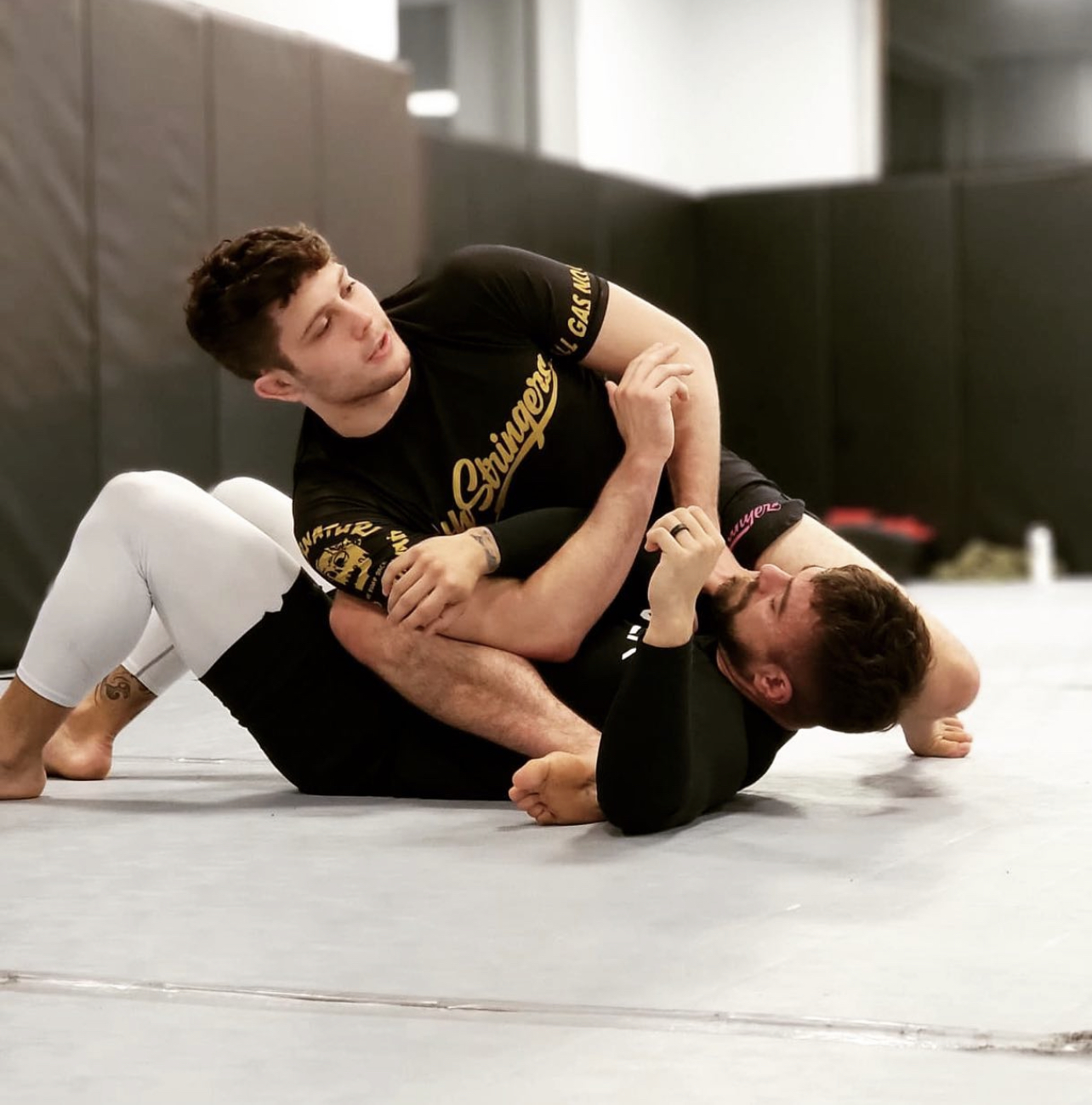Jiu-Jitsu: Underneath the Umbrella of Martial Arts
The history and application of Brazilian Jiu-Jitsu through the lenses of two lifelong fighters
COURTESY OF GABBY ETZEL
A key component of jiu-jitsu is using leverage to immobilize one’s opponent. The playing field is level, as smaller competitors often defeat larger ones.
March 23, 2022
When you think of a fighter, what are some names that come to mind? Mike Tyson, Dwayne “The Rock” Johnson, Muhammad Ali? People associate the idea of a fighter with someone who is tall and muscular. While strength is a key component to fighting, there are ways to defend yourself without being as strong or tall as the person in front of you.
Jiu-jitsu is a sport that has grown in popularity over the past 50 years. Fighters, regardless of their size, are able to learn and partake in the martial art. The sport was initially designed for smaller fighters, creating more opportunities for all aspiring martial artists to compete.
Gabby Etzel, Fordham College at Lincoln Center ’22, began her jiu-jitsu career at 13 years old and is currently a purple belt, a rank that only 10% of people who participate in jiu-jitsu reach. Etzel never felt vulnerable in New York because of her size, given her long history in the sport.
“‘Could I defend myself against an attacker on the street who’s twice my size?’ isn’t a question for me.” Gabby Etzel, FCLC ’22
“‘Could I defend myself against an attacker on the street who’s twice my size?’ isn’t a question for me,” she declared.
The decorated 5’4” and 104-pound fighter is currently training for her finals match at the Pan-American Championship and quarterfinals match at the 2022 World Jiu-Jitsu Championship.
There are different analogies for what mixed martial arts is like. Some people think of it as a tree with varying branches that break off into different types of fighting. But third-ranked brown belt of the International Brazilian Jiu-Jitsu Federation Sean Yadimarco thinks of the art as an umbrella.
“There’s a lot of things under the umbrella,” Yadimarco said. He explained that the different styles of martial arts and the two techniques that are used, striking and grappling, tie into one another.
Underneath “grappling” lies wrestling, jiu-jitsu and judo. For striking, there are some of the typical sports that people associate with martial arts, like Muay Thai, boxing and kickboxing.
Yadimarco’s specialty is Brazilian Jiu-Jitsu. He has spent over a decade studying and training in the practice.
The sport was created by Mitsuyo Maeda when he immigrated to Brazil from Japan in the early 1900s and began to teach judo, Yadimarco shared. While in Brazil, Maeda met Gastão Gracie, a Brazilian businessman who helped Maeda emigrate from Japan. As a sign of gratitude, Maeda began to teach judo to Gastão’s sons, Carlos and Helio.
The slow birth of Brazilian Jiu-Jitsu began as Carlos focused more on using leverage instead of relying on strength to defeat larger opponents.
“Carlos and Helio Gracie were learning judo from Mitsuyo Maeda, (but) they had to innovate a little because they were smaller, weaker,” Yadimarco explained. “They were 140-150 pound men. That’s not very big for men.”
The slow birth of Brazilian Jiu-Jitsu began as Carlos focused more on using leverage instead of relying on strength to defeat larger opponents. His brother Helio was significantly weaker and even had trouble making it up stairs without fainting or feeling lightheaded. But by watching his brother compete, Helio further modified the techniques and eventually created Brazilian — also known as “Gracie” — jiu-jitsu.
The new sport proved to be effective against larger opponents as Helio continued to train and compete against martial artists. He later faced world heavyweight wrestling champion Władek ”Great Apollo” Zbyszko, and the match against the 6’3” wrestler ended in a draw.

Helio continued to fight reputable competitors; in 1951, he went against Masahiko Kimura, the second-ranked judoka in the world that year who outweighed Helio by almost 80 pounds. Helio lost that match, but Kimura was so impressed by Helio’s abilities that he invited him to teach Brazilian jiu-jitsu in Japan. Although the match was a defeat for Helio, it is known as one of his greatest victories.
Both Yadimarco and Etzel have their own relationship with jiu-jitsu, finding their niche within different aspects of the sport.
Yadimarco found that the sport forces him to pace out his thoughts as he contemplates his next move.
“Jiu-jitsu constantly makes me problem-solve, and it keeps it very interesting for me,” Yadimarco explained. “There’s a lot of ways for me to be creative to solve constant problems and dilemmas that my opponents can give me.”
For Etzel, the community within the sport was her niche, especially in her home gym, the Hive Martial Arts Academy.
“My training partners there have made my game what it is today … They’re just really great people that helped me keep a good head on my shoulders,” she said.
“You’re learning to defend yourself while doing something fun (and) while losing weight, all at the same time.” Sean Yadimarco
While every person will find their own aspect of jiu-jitsu to fall in love with, the benefits remain the same. Yadimarco considers jiu-jitsu a “cheat code” to personal development. While working out in a regular gym alone has benefits, according to Yadimarco, practicing jiu-jitsu provides another path to a person’s fitness goals.
“You’re learning to defend yourself while doing something fun (and) while losing weight, all at the same time,” he explained.
Many who take up jiu-jitsu also find that their confidence increases. Jiu-jitsu is practical, real-life scenario training. When “you get into a real-life situation,” Yadimarco explained, “you can have the confidence to defend yourself” because of the training on the mat.
Jiu-jitsu was designed for smaller opponents to take on competitors who are much larger. Etzel calls jiu-jitsu an “even playing ground” because of the sport’s accessibility to anyone ranging from recreational to professional fighters. Carlos and Helio Gracies’ sport has continued to positively influence competitors, opening the doors of martial arts to anyone with an interest.














